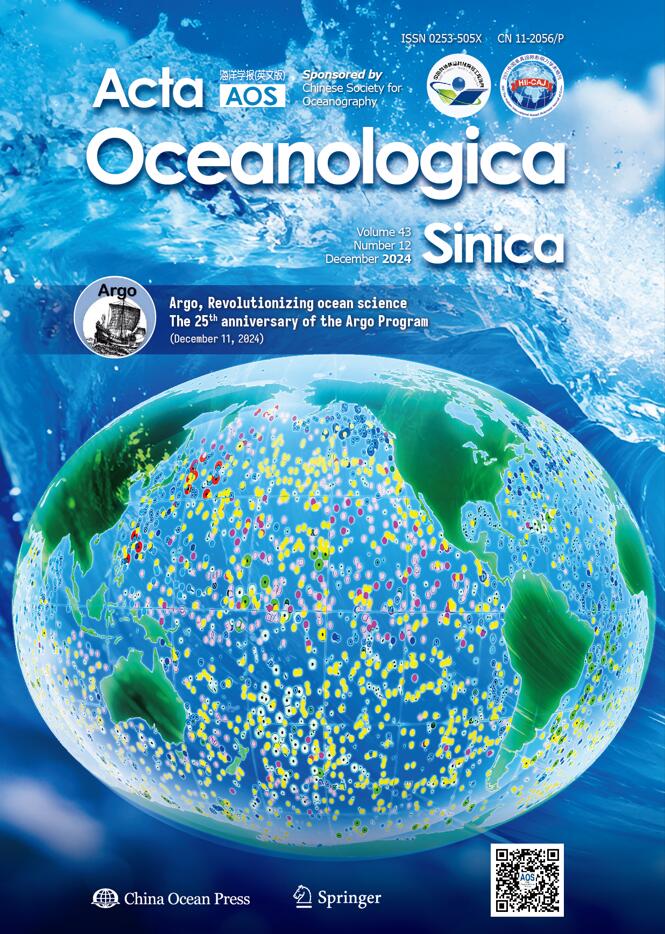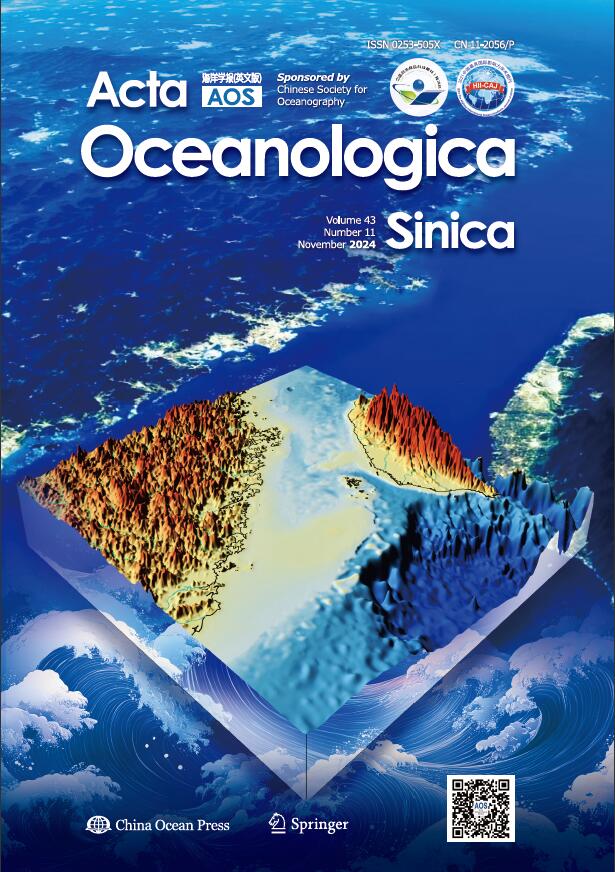2022 Vol. 41, No. 4
Display Method:
2022, 41(4): 1-13.
doi: 10.1007/s13131-021/1847-6
Abstract:
The unbalanced submesoscale motions and their seasonality in the northern Bay of Bengal (BoB) are investigated using outputs of the high resolution regional oceanic modeling system. Submesoscale motions in the forms of filaments and eddies are presen...
The unbalanced submesoscale motions and their seasonality in the northern Bay of Bengal (BoB) are investigated using outputs of the high resolution regional oceanic modeling system. Submesoscale motions in the forms of filaments and eddies are presen...
2022, 41(4): 14-22.
doi: 10.1007/s13131-021-1854-7
Abstract:
The horizontally variable density stratification and background currents are taken into the variable-coefficent extended Korteweg-de Vries (evKdV) theory to obtain the geographical and seasonal distribution of kinematic parameters of internal solitar...
The horizontally variable density stratification and background currents are taken into the variable-coefficent extended Korteweg-de Vries (evKdV) theory to obtain the geographical and seasonal distribution of kinematic parameters of internal solitar...
2022, 41(4): 23-39.
doi: 10.1007/s13131-021-1873-4
Abstract:
In the northern Bay of Bengal, the existence of intense temperature inversion during winter is a widely accepted phenomenon. However, occurrences of temperature inversion during other seasons and the spatial distribution within and adjacent to the Ba...
In the northern Bay of Bengal, the existence of intense temperature inversion during winter is a widely accepted phenomenon. However, occurrences of temperature inversion during other seasons and the spatial distribution within and adjacent to the Ba...
2022, 41(4): 40-56.
doi: 10.1007/s13131-021-1852-9
Abstract:
Satellite altimetry observations, including the upcoming Surface Water and Ocean Topography mission, provide snapshots of the global sea surface high anomaly field. The common practice in analyzing these surface elevation data is to convert them into...
Satellite altimetry observations, including the upcoming Surface Water and Ocean Topography mission, provide snapshots of the global sea surface high anomaly field. The common practice in analyzing these surface elevation data is to convert them into...
2022, 41(4): 57-67.
doi: 10.1007/s13131-021-1826-z
Abstract:
With the accelerated warming of the world, the safety and use of Arctic passages is receiving more attention. Predicting visibility in the Arctic has been a hot topic in recent years because of navigation risks and opening of ice-free northern passag...
With the accelerated warming of the world, the safety and use of Arctic passages is receiving more attention. Predicting visibility in the Arctic has been a hot topic in recent years because of navigation risks and opening of ice-free northern passag...
2022, 41(4): 68-79.
doi: 10.1007/s13131-021-1829-8
Abstract:
Antarctic Bottom Water (AABW) plays an important role in the meridional overturning circulation and contributes significantly to global heat transport and sea level rise (SLR). Based on the Global Ocean (1/12)° Physical Reanalysis (GLORYS12V1) produc...
Antarctic Bottom Water (AABW) plays an important role in the meridional overturning circulation and contributes significantly to global heat transport and sea level rise (SLR). Based on the Global Ocean (1/12)° Physical Reanalysis (GLORYS12V1) produc...
2022, 41(4): 80-90.
doi: 10.1007/s13131-021-1942-8
Abstract:
The concentrations of five forms of phosphorus (P) including exchangeable or loosely adsorbed P (Ex-P), Fe-bound P (Fe-P), authigenic P (Auth-P), detrital P (Det-P), and organic P (Org-P) from the basin among the Marcus-Wake seamounts (19.4°–24°N, 15...
The concentrations of five forms of phosphorus (P) including exchangeable or loosely adsorbed P (Ex-P), Fe-bound P (Fe-P), authigenic P (Auth-P), detrital P (Det-P), and organic P (Org-P) from the basin among the Marcus-Wake seamounts (19.4°–24°N, 15...
2022, 41(4): 91-100.
doi: 10.1007/s13131-021-1851-x
Abstract:
Deep-seated gas in seabed sediments migrates upwards from effect of external factors, which easily accumulates to form gasbags at interface of shallow coarse-fine sediments. Real-time monitoring of this process is important to predict disaster. Howev...
Deep-seated gas in seabed sediments migrates upwards from effect of external factors, which easily accumulates to form gasbags at interface of shallow coarse-fine sediments. Real-time monitoring of this process is important to predict disaster. Howev...
2022, 41(4): 101-108.
doi: 10.1007/s13131-021-1965-1
Abstract:
Seasonal location and intensity changes in the western Pacific subtropical high (WPSH) are important factors dominating the synoptic weather and the distribution and magnitude of precipitation in the rain belt over East Asia. Therefore, this article ...
Seasonal location and intensity changes in the western Pacific subtropical high (WPSH) are important factors dominating the synoptic weather and the distribution and magnitude of precipitation in the rain belt over East Asia. Therefore, this article ...
2022, 41(4): 109-118.
doi: 10.1007/s13131-021-1943-7
Abstract:
A Leeway-Trace model was established for the traceability analysis of drifting objects at sea. The model was based on the Leeway model which is a Monte Carlo-based ensemble trajectory model, and a method of realistic traceability analysis was propose...
A Leeway-Trace model was established for the traceability analysis of drifting objects at sea. The model was based on the Leeway model which is a Monte Carlo-based ensemble trajectory model, and a method of realistic traceability analysis was propose...
2022, 41(4): 119-128.
doi: 10.1007/s13131-021-1944-6
Abstract:
Piezocone penetration test (CPTu), the preferred in-situ tool for submarine investigation, is significant for soil classification and soil depth profile prediction, which can be used to predict soil types and states. However, the accuracy of these me...
Piezocone penetration test (CPTu), the preferred in-situ tool for submarine investigation, is significant for soil classification and soil depth profile prediction, which can be used to predict soil types and states. However, the accuracy of these me...
2022, 41(4): 129-137.
doi: 10.1007/s13131-021-1855-6
Abstract:
We aim to directly invert wave parameters by using the data of a compact polarimetric synthetic aperture radar (CP SAR) and validate the effectiveness of ocean wave parameter retrieval from the circular transmit/linear receive mode and π/4 compact po...
We aim to directly invert wave parameters by using the data of a compact polarimetric synthetic aperture radar (CP SAR) and validate the effectiveness of ocean wave parameter retrieval from the circular transmit/linear receive mode and π/4 compact po...
2022, 41(4): 138-145.
doi: 10.1007/s13131-021-1842-y
Abstract:
In this study a novel synthetic aperture radar (SAR) scattering model for sea surface with breaking waves is proposed. Compared with existing models, the proposed model considers an empirical relationship between wind speed and wave breaking scatteri...
In this study a novel synthetic aperture radar (SAR) scattering model for sea surface with breaking waves is proposed. Compared with existing models, the proposed model considers an empirical relationship between wind speed and wave breaking scatteri...
2022, 41(4): 146-156.
doi: 10.1007/s13131-021-1827-x
Abstract:
The melt onset dates (MOD) over Arctic sea ice plays an important role in the seasonal cycle of sea ice surface properties, which impacts Arctic surface solar radiation absorbed by the ice-ocean system. Monitoring interannual variations in MOD is val...
The melt onset dates (MOD) over Arctic sea ice plays an important role in the seasonal cycle of sea ice surface properties, which impacts Arctic surface solar radiation absorbed by the ice-ocean system. Monitoring interannual variations in MOD is val...














